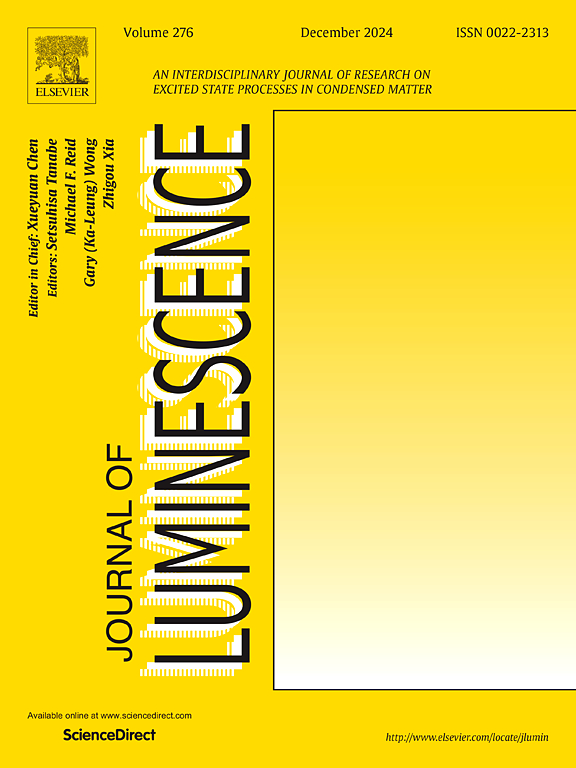Radiation dose dependence of the Bi3+ luminescence in YPO4
IF 3.3
3区 物理与天体物理
Q2 OPTICS
引用次数: 0
Abstract
The UV persistent phosphors YPO4:Bi were synthesized using both solid-state reaction and hydrothermal methods. XRD and SEM analyses confirmed the formation of single-phase powders. The solid-state synthesis resulted in ‘large’ particle sizes (1–4 μm), while the hydrothermal synthesis produced ‘small’ particle sizes (30–45 nm). The emission centers providing UV-C and UV-A luminescence under X-ray excitation are single Bi3+ ion and Bi3+– Bi3+ pairs. The highest emission yield was observed for samples with a Bi3+ concentration of 0.6 mol.%. An analysis of thermoluminescence glow curves using the general order kinetics model, revealed hole traps with an activation energy of 0.93–1.05 eV and electron traps with an activation energy of 0.75–0.85 eV. The dominant mechanisms for UV-C and UV-A emission involve hole recombination at Bi2+ ions and electron recombination at Bi3+– Bi4+ pairs, respectively. The optimal X-ray irradiation dose is 10–12 Gy. The UV-C and UV-A afterglow curves at room temperature follow the sum of exponential and first-order hyperbola functions, corresponding to electron recombination through the conduction band and hole recombination via tunneling, respectively. The afterglow durations for the solid-state prepared powder are 40 min for UV-A and 10 min for UV-C. The powder synthesized by hydrothermal method shows a significant reduction in intensity of afterglow due to the surface energy losses. Notably, despite the decreased intensity, there is a significant increase in the duration of the tunneling component responsible for UV-C emission, attributed to the reduced average distance between the emission center and the hole trap. Methods for improving the afterglow characteristics of YPO4:Bi nanoparticles are proposed.
YPO4 中 Bi3+ 发光的辐射剂量依赖性
采用固态反应和水热法合成了紫外持久性荧光粉 YPO4:Bi。XRD 和 SEM 分析证实了单相粉末的形成。固态合成产生了 "大 "粒径(1-4 μm),而水热合成则产生了 "小 "粒径(30-45 nm)。在 X 射线激发下,提供 UV-C 和 UV-A 发光的发射中心是单个 Bi3+ 离子和 Bi3+- Bi3+ 对。在 Bi3+ 浓度为 0.6 摩尔%的样品中观察到了最高的发射率。利用一般阶次动力学模型对热发光辉光曲线进行分析,发现空穴陷阱的活化能为 0.93-1.05 eV,电子陷阱的活化能为 0.75-0.85 eV。UV-C 和 UV-A 辐射的主要机制分别涉及 Bi2+ 离子的空穴重组和 Bi3+- Bi4+ 对的电子重组。最佳 X 射线辐照剂量为 10-12 Gy。室温下的 UV-C 和 UV-A 余辉曲线遵循指数函数和一阶双曲线函数之和,分别对应于电子通过导带重组和空穴通过隧道重组。固态制备的粉末在紫外-A 波段的余辉持续时间为 40 分钟,在紫外-C 波段的余辉持续时间为 10 分钟。水热法合成的粉末由于表面能量损失,余辉强度显著降低。值得注意的是,尽管强度降低了,但由于发射中心与空穴陷阱之间的平均距离缩短,导致 UV-C 发射的隧道成分持续时间显著增加。本文提出了改善 YPO4:Bi 纳米粒子余辉特性的方法。
本文章由计算机程序翻译,如有差异,请以英文原文为准。
求助全文
约1分钟内获得全文
求助全文
来源期刊

Journal of Luminescence
物理-光学
CiteScore
6.70
自引率
13.90%
发文量
850
审稿时长
3.8 months
期刊介绍:
The purpose of the Journal of Luminescence is to provide a means of communication between scientists in different disciplines who share a common interest in the electronic excited states of molecular, ionic and covalent systems, whether crystalline, amorphous, or liquid.
We invite original papers and reviews on such subjects as: exciton and polariton dynamics, dynamics of localized excited states, energy and charge transport in ordered and disordered systems, radiative and non-radiative recombination, relaxation processes, vibronic interactions in electronic excited states, photochemistry in condensed systems, excited state resonance, double resonance, spin dynamics, selective excitation spectroscopy, hole burning, coherent processes in excited states, (e.g. coherent optical transients, photon echoes, transient gratings), multiphoton processes, optical bistability, photochromism, and new techniques for the study of excited states. This list is not intended to be exhaustive. Papers in the traditional areas of optical spectroscopy (absorption, MCD, luminescence, Raman scattering) are welcome. Papers on applications (phosphors, scintillators, electro- and cathodo-luminescence, radiography, bioimaging, solar energy, energy conversion, etc.) are also welcome if they present results of scientific, rather than only technological interest. However, papers containing purely theoretical results, not related to phenomena in the excited states, as well as papers using luminescence spectroscopy to perform routine analytical chemistry or biochemistry procedures, are outside the scope of the journal. Some exceptions will be possible at the discretion of the editors.
 求助内容:
求助内容: 应助结果提醒方式:
应助结果提醒方式:


